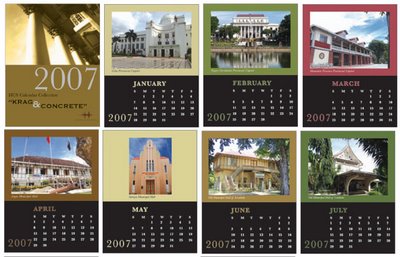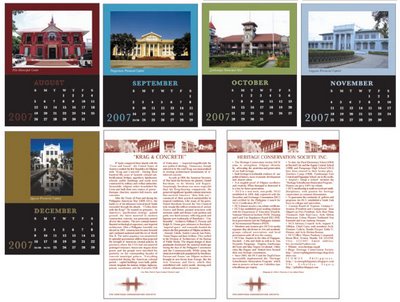
 The HCS will be featuring fine examples of built heritage structures transformed into commercially-sustainable business projects. You will find elegant family residences that have been recycled into boutique hotels and banks; a century-old train terminal (Tutuban) became a shopping mall and the first international airport of Manila (Nielson Tower) was restored and recycled into a library and bookstore.
The HCS will be featuring fine examples of built heritage structures transformed into commercially-sustainable business projects. You will find elegant family residences that have been recycled into boutique hotels and banks; a century-old train terminal (Tutuban) became a shopping mall and the first international airport of Manila (Nielson Tower) was restored and recycled into a library and bookstore.All these are compiled into the 2008 Heritage Calendar/Postcard Collection called HERITAGE RECYCLED. These unique calendars are excellent Christmas gifts to your friends and business associates. You can also have your company and/or personal logo printed on the standee.
As you know, the HCS is a non-profit group. One of our main objectives is to show how the restoration of heritage structures can enhance the value of real estate development projects, urban planning, and tourism.
By ordering, you will be contributing to this worthwhile advocacy. (P200/copy; 10% discount for members and bulk orders of 100pcs++)
Thank you for your valued support. E-mail us at info@heritage.org.ph
* * *
HERITAGE RECYCLED
Adaptive re-use is a creative mode of conservation that gives heritage structures new and alternative functions other than the original ones that may no longer be required.
Adaptive re-use is applicable to most heritage structures. These need not be as grandiose as the vintage Department of Finance, now the National Museum. HCS did not include it to show that ancestral homes of modest proportions, obscure town halls, colonial watchtowers and bridges, warehouses and train stations can also be recycled into sustainable projects.
Most often than not, built heritage resources are found on premium real estate property so developers are in a hurry to demolish rather than restore and recycle. Today, there is a growing awareness that adaptive re-use can enhance property value.
In many countries, like Australia for example, demolition of heritage structures is considered wasteful. Heritage resources are given adaptive re-use because it is good for the environment. Recycling a valued heritage place makes adaptive re-use of historic buildings an essential component of sustainable development. The United States of America abounds with examples of creative (and remunerative) re-use of heritage. Old warehouses in Manhattan's meat-packing areas have been transformed into fashionable and expensive lofts. Elegant mansions in "Gone with the Wind" country were transformed into boutique hotels.
In London, a power plant along the River Thames became the elegant Tate Gallery of Modern Art. In Mexico City, the Cemento Azteca plant is now an environment-friendly children's museum-- El Papalote. Singapore has salvaged a cluster of decrepit shop houses, turning Boat Quay and Clarke Quay into an eclectic mix of high-end restaurants, al fresco dining, dazzling bars and pubs.
We are not too far behind in the Philippines that is why the HCS has chosen "Heritage Recycled" as its theme for 2008. Until now, you may not have noticed these twelve amazing projects of sustainable, adaptive re-use. Take a good look around you and find more incredible examples of how Filipinos have so creatively recycled heritage.
However, in the Philippine scene, recycling heritage and adaptive re-use are still polemical issues. Should heritage conservation be done strictly "in situ"? Should heritage structures be transferred to different sites and settings, when that is the only way to save them? Is adaptive re-use intrusive? Or, should heritage conservation be a priority at all? Let the debate begin. After which we, conservation advocates, can make policies suitable to our own needs and vision.



